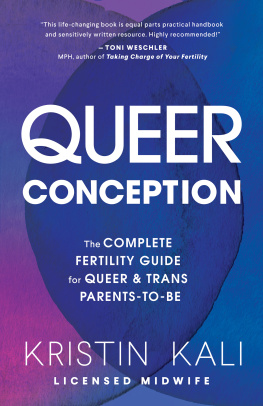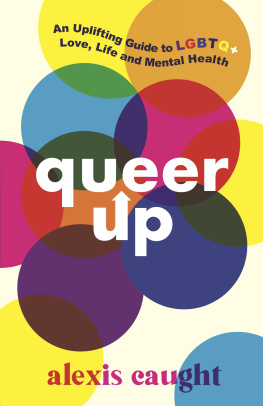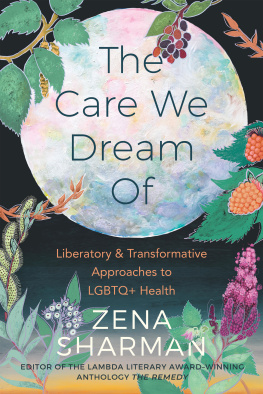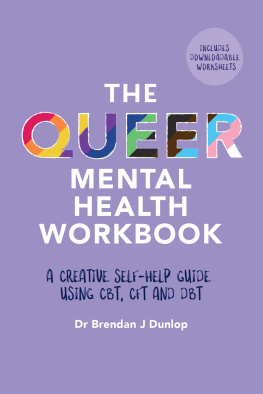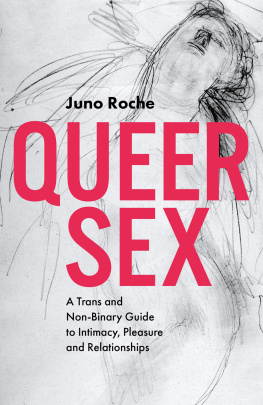MORE PRAISE FOR
THE REMEDY
A welcome trend in clinical education and practice involves inviting patients and clients to tell their own stories of identity, illness, health care and resilience in their own words, to both learners and practitioners. The Remedy provides a rich tapestry of narratives across the spectrum of human sexuality and genders, and includes descriptions of innovations from committed health professionals who address the many gaps in providing attuned, informed care to queer and trans people.
Allan Peterkin, MD, and co-author of Caring for Lesbian and Gay People: A Clinical Guide
The Remedy is a bandage lovingly placed on the open wounds of every LGBTQAI person afraid of going to a doctor. This book does not just ask doctors to follow the oath of first do no harm; it also demands medical practitioners respect, understand, and affirm our queer lives, bodies, and families. The Remedy is the collection of healing and solidarity queers desperately need.
Sassafras Lowrey, author of Lost Boi
The Remedy is a book to give to anyone working in health care, to queer and trans friends struggling to find their voice through an illness, to your straight parents and queer or trans children. The candour in this collection filled me with that relief and gratitude one senses from feeling deeply seen. Here are quintessential stories of queer and trans people navigating our health care and medical systems. If youre queer or trans, these confidences will be nothing short of healing. If youre a medical practitioner, theyll be vital.
Michael V. Smith, author of My Body Is Yours
The best kind of waiting-room reading, The Remedy brings together many voices to offer something we often dont find through our health-care providers. Zena Sharman has collected points of view from many sides of medical interactions, creating a community of people who truly believe that the barriers to medical access that LGBTQIA people face are unjust but changeable.
Rae Spoon, author of First Spring Grass Fire

THE REMEDY
Copyright 2016 by the Contributors
All rights reserved. No part of this book may be reproduced in any part by any meansgraphic, electronic, or mechanicalwithout the prior written permission of the publisher, except by a reviewer, who may use brief excerpts in a review, or in the case of photocopying in Canada, a license from Access Copyright.
ARSENAL PULP PRESS
Suite 202 211 East Georgia St.
Vancouver, BC V6A 1Z6
Canada
arsenalpulp.com
The publisher gratefully acknowledges the support of the Canada Council for the Arts and the British Columbia Arts Council for its publishing program, and the Government of Canada (through the Canada Book Fund) and the Government of British Columbia (through the Book Publishing Tax Credit Program) for its publishing activities.

Design and cover illustration by Oliver McPartlin
Edited by Brian Lam with Linda Field
Editorial assistance by Claire Matthews
Illustrations for Innovation Profiles by Sam Bradd
Library and Archives Canada Cataloguing in Publication:
The remedy: queer and trans voices on health and health care / edited by Zena Sharman.
Includes bibliographical references.
Issued in print and electronic formats.
ISBN 978-1-55152-659-1 (html)
1. GaysMedical care. 2. GaysHealth and hygiene. 3. Transgender people--Medical care. 4. Transgender peopleHealth and hygiene. I. Sharman, Zena, 1979-, editor
RA564.9.H65R44 2016 362.108664 C2016-904412-2
C2016-904413-0
CONTENTS

Table of Contents
Guide

Im at my friends house for dinner, perched on a barstool in front of a kitchen island stocked with snacks. Four of us are gathered around the food, all queer, one trans. Two of my companions are cancer survivors who trade stories about treatments, symptoms, and chronic pain. They share a kinship and a form of solidarity that Im grateful to witness. The rest of us listen intently as one describes a cross-border search and reading hundreds of plastic surgery journal articles in search of a cure for an injury theyd sustained during a botched diagnostic procedure, something doctors told them would inevitably lead to surgery and living the rest of their life with a colostomy bag. I hold my breath, tense with anticipation as my friends tale of tenacity and self-advocacy unfolds, exhale a sigh of relief as they recount the final, triumphant chapter. It seems sweeter, queerer somehow that the story ends with a miracle cure in San Francisco.
I glance at my phone, a reflexive action I repeat casually and almost without thinking many times a day. This time, the words on the screen grab my full attention, fill me with a mix of empathy and rage as I read a text from a friend, upset and triggered following a violating encounter with a physician. Shes a visibly queer Aboriginal person with a masculine gender presentation. This shouldnt be relevant to her traumatic medical experience, but it is, because mine probably wouldve been different. Im a white femme with a PhD, prone to geeking out with my care providers about health research during appointments. No doctor has ever treated me the way they treated my friend. I sit with her words for a moment, take them in, feel acutely aware of how my gender and white privilege shape the inequity of our experiences. I tell my friend how sorry I am that this happened to her, affirm that the doctors behaviour was awful and inappropriate. I channel my anger into looking up information on how to file a complaint against a physician, send it to her, and hope that my friends grievance is taken seriously, that theres some remedy, some recourse, that this doesnt happen to anybody else.
My hair stylista fellow queer femmeis cutting my hair and updating me about her efforts to get pregnant through IVF. Shes being implanted with her partners egg and donor sperm. Theyre paying out of pocket at the fertility clinic known as the go-to place for queers in Vancouver, but the rainbow flag on the website doesnt protect against the kind of institutionalized heteronormativity they encounter at every turn. I watch her in the mirror as she tells me about how the clinic keeps mixing her up with her partner when it communicates with them by phone or email, how they were given an information sheet for straight couples and told to ignore the instructions for the man. I go on a feminist rant about patriarchy and evidence-based medicine when she describes how the clinic told her not to have an orgasm for three weeks after the first implantation attempt. Later, I post a question about the validity of these instructions on social media. A group of mostly queer friends that includes a midwife, a labour and delivery nurse, a naturopath, several of North Americas leading sex researchers, and a handful of parents collectively arrive at an answer. They dont make pamphlets for this sort of thing.
A common thread connects these narratives: the power of stories and how health information circulates in queer and trans communities. Who the good queer- and trans-competent family doctors are (and whos accepting patients). How to navigate the process of getting public funding for gender-affirming surgery and how to heal from that surgeryall of the things not captured in the surgeons standard post-operative instruction sheetlike my friends the cancer survivors, the kind of knowledge you only accumulate by living it.


